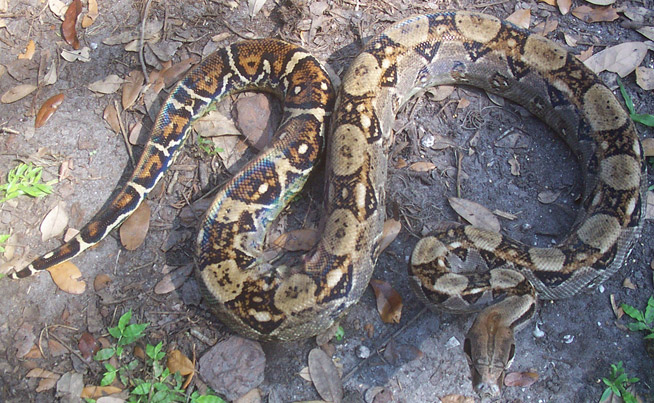
Biology:
The Boa constrictor is one of the largest snake species in the world. It can reach a maximum length of 13 feet (4 meters), with the female boa usually reaching a longer length than male boa. Many female boas will exceed ten feet in length; most males, on the other hand, tend to reach the modest length of seven feet. Furthermore, boa snakes can weigh up to 27 kg – their weight usually has a direct correlation with their length. Red-tailed Boa, for example, tends to be one of the heavier species of boa, many of them having an average weight of around 20 kg.
The name red-tailed boa comes from the coloring of the boa constrictors. They usually have a base color that is brown or grey. Most boas have what are known as ‘saddles’ – patterned spots that become more apparent in the tail of the snake. These spots are reddish brown. This coloring is essential as camouflage for wild boas in jungles and forests.
Habitat:
One reason why boas have been able to thrive in various regions throughout the globe is because they are a very adaptive species; in other words, they can exist, and exist well, is a number of different environments. Primarily, boas are found to live in rainforests. This is because boas prefer to live in a humid environment, as well as a habitat that has lot of tree color (hiding places). Within these distinct habitats boas are mainly found along rivers and streams. Sometimes, a boa will take over the homes of the lesser mammals in the area.
Red tailed boas in Florida are found near the coast. They are rarely seen in the wild; most Florida boas are held captive and exist domestically and in zoos.
In Florida: Although native to South America, some boa constrictors live in Florida, and have established breeding self-sustaining populations. This is most common in southern FL, in and near the everglades, where the subtropical climate can support them. You may find
boas in Miami or Naples. In Orlando, Tampa, or Jacksonville, temperatures usually get too cold to support these snakes. However, I sometimes come across them in Florida - they are surely released pets. I don't know how long they can survive in Orlando, but it may be for a few years,
provided that the temperature doesn't drop too low.
Behavior:
One of the main aspects of boa constrictor’s behavior is that they are very solitary. In general, boas will only be found together when they are undergoing the mating process; otherwise, boas will live and hunt alone.
Young boas are more likely to be found living in trees, as they are lighter, while older boas stick to the ground (usually due to their large weight and length). They are nocturnal animals that will hunt for food at night and sleep, and hide, during the day.
Boas will only strike when they feel as if they are in danger. A bite from a boa constrictor, although powerful, is not lethal. This is because there is no venom in a boa constrictor. They kill their prey by constriction, as the name implies. It’s important to note that boas that are in a ‘shed cycle’ – a time when they skin is shedding – they become much more volatile. Scientists have yet to determine exactly why this is, but one theory is that it’s because the snake’s vision becomes seriously affected and this causes it extreme discomfort.
Diet:
A boa constrictor’s diet includes a great variety of different animals. A few of the more common prey of a boa are rodents and birds. Some boa constrictors have been known to consume mammals as large as ocelots. In general, young boas will stick to a diet of small mice, bats and lizards. The rule of thumb is that, as a boa gets older and larger, so do the prey it eats.
Known as sneaky predators, boas will wait for long periods of time – in both day and night – until they have an opportunity to strike a prey. The method of attack for a boa is a simple one: it strikes the prey with its teeth and then, while the prey is still in shock, will begin to constrict the prey to death. It takes a boa 4-6 days to fully consume and digest its
food. Afterwards, red tailed boas won’t eat for a long duration of time.
Reproductive:
One main feature of the reproduction of boa snakes is that they give birth to live young. Breeding usually occurs during the end of spring and the beginning of summer; males are known to mate with multiple females during this time period. In rare occasions, boa constrictors are known to have produced offspring asexually. Boa constrictors become sexually mature and are able to mate between the age of three and four. Most boa constrictors that give birth to offspring are at least six feet in length.
You can also read about another Florida invasive snake, the Burmese Python in Florida
Many people want to know how to kill a Red Tailed Boa Constrictor, but you don't need to. The
best way to get rid of Red Tailed Boa Constrictors is to simply leave them alone. You can also
use a Red Tailed Boa Constrictor trap to catch them - that's one of the best ways for how to
remove Red Tailed Boa Constrictor. For more information, go to my
Snake Removal - How to Get Rid of Snakes home page.
If you need Red Tailed Boa Constrictor removal in your city, I have friends that I have
personally trained in several Florida cities.